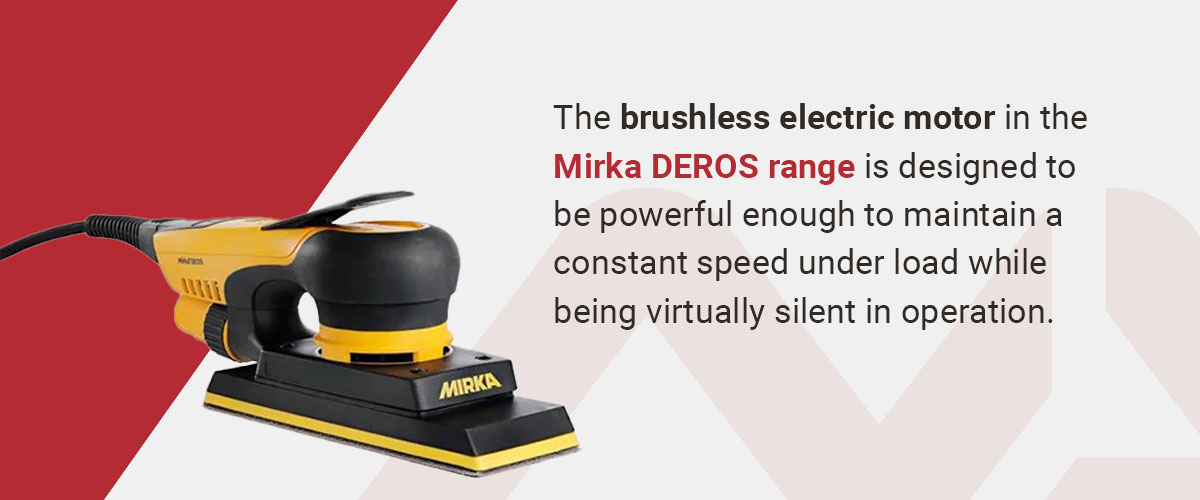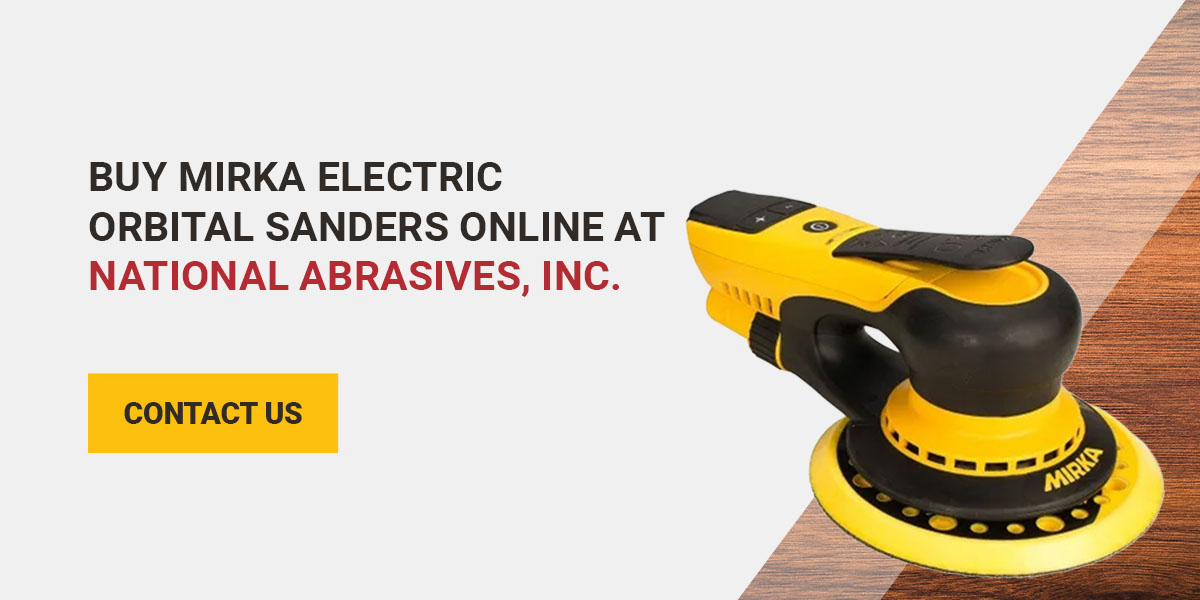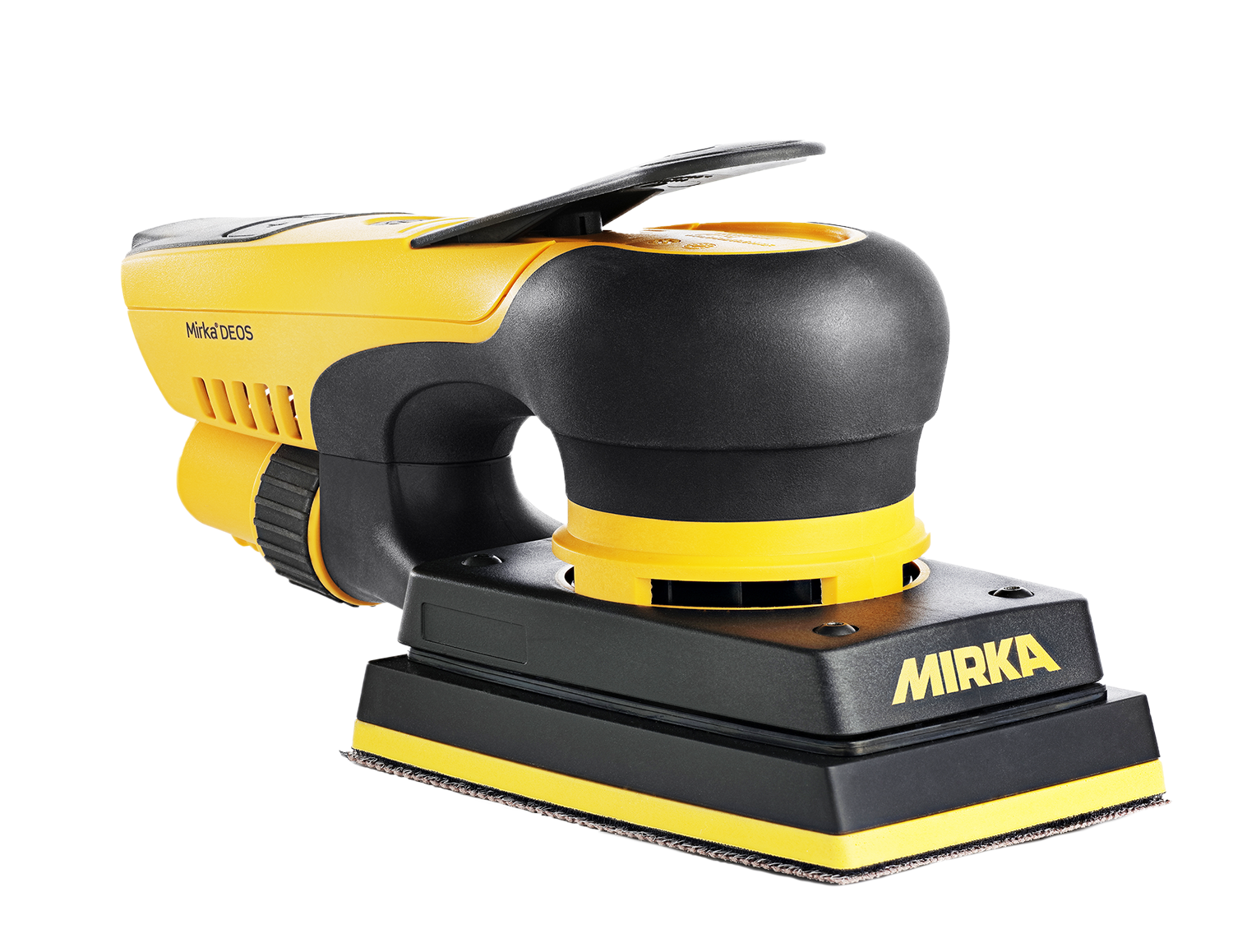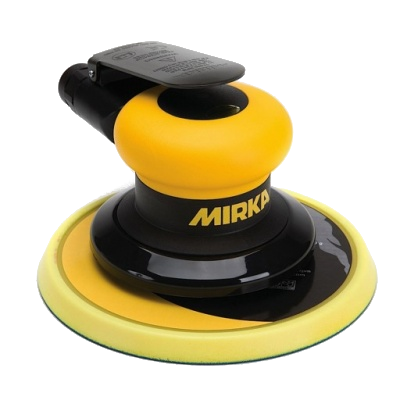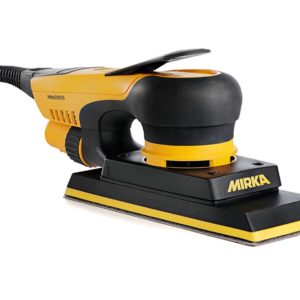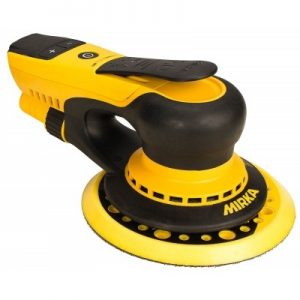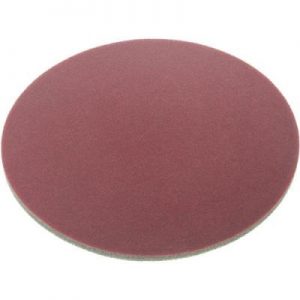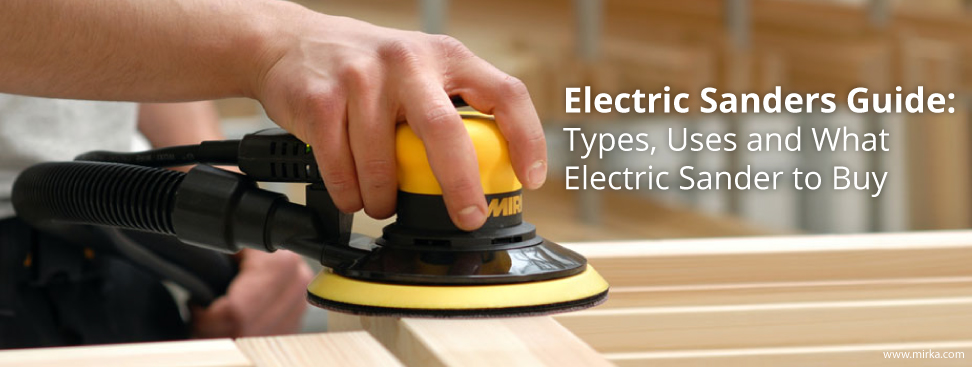
Best Electrical Orbital Sanders
This electric sanders guide provides a comprehensive overview of electric sanders. It covers the most common types of electric sanders, how to use them and tips to help you achieve optimal results in the workshop and on job sites.
Buyer’s Guide to Electric Random Orbital Sanders
When it’s time to sand woodwork, walls, furniture, metal or other objects on the job site, there are various options. Choices include completing sanding projects by hand or using a battery-operated pneumatic sander or an electric sander. Most people prefer power tools for sanding because sanding by hand can be slow and tedious. Even so, some projects require brute force and hand sanding.
For a lighter and quieter tool, you might choose from various pneumatic sanders as they do not have a motor. Pneumatic sanders also cost less than their electric counterparts, but they require a big air compressor because its repeated cycles quickly burn out a smaller unit. One of the most significant disadvantages of using a pneumatic sander is that most units don’t have a dust connector attachment.
For many jobs, an electric sander makes the most sense. Power or electric sanders have a motor that energizes the sanding head containing a sleeve, sanding pad and belt. The motor causes the sandpaper to move against the surface of the work. A power hand sander allows you to complete a sanding task faster. This means you can finish jobs within minutes using an electric sander that typically takes hours to complete by hand.
Before you get to the job site, it is best to consider the type of material you are working with, the extent of the job and the type of surface finish you need. In many cases, a powerful random orbital sander will be an excellent selection or at least a tool that you should have in your workshop or work van. This guide compares the best random orbital sanders with similar tools, explains what properties are worth looking at and some of the best practices.
Primary Types of Electric Sanders
The machine you and your team select should be project-relevant. Choosing a sander that will deliver excellent results with minimal effort is essential.
Disk Sanders
This sander consists of a pad or disk that functions as a support for a circular-shaped piece of abrasive or sandpaper. The backing pad has a bolt and large washer that goes to the center of the disc, or a gum-like adhesive that holds the sandpaper in place.
A rudimentary disk sander, mainly appropriate for handymen and DIYs use, consists of a sanding disk attachment, which fits into a standard electric drill. The problem with this setup is that the average electric drill doesn’t rotate at the high speeds required for sanding projects. In addition, a sanding disk attachment can quickly burn out the drill’s bearings because most drills lack the capacity for the twisting or side-thrust action generated by electric sanders — making this option inappropriate for workshops and job sites.
The most common disk sander found on job sites or in workstations is a portable handheld piece of equipment that can either be corded or have rechargeable batteries. However, you also get stationary disk sanders for heavy-duty sanding jobs, smaller tabletop disc sanders, and combination sanders with both belt and disk. Disk sanders are mainly ideal for the initial smoothing of certain rough surfaces, helping shape materials such as wood and metal and removing unwanted rust or paint.
Although you can use a disk sander for specific material and project area smoothing, it is critical that you don’t use a disk sander on doors, furniture, cabinets or flat wood trim, whether on the interior or exterior, because it’s difficult to control the disk sander on flat surfaces.
In addition, due to their fixed rotational patterns, disk sanders are known to dig into the wood and create swirls and circular gouges on the work surface. Disk sanders should be used where less finesse and precision are needed, such as for initial preparation, sanding off peeling paint or drywall, removing larger amounts of material or shaping materials.
Electric Random Orbital Sanders
The electric random-orbital sander is an effective tool for sanding and finishing projects because it has a round, abrasive pad that moves in small circles or random orbits. The best electric random orbital sanders you can choose from allow you to sand in any direction. They have great versatility because they can handle general projects ranging from rough to finish sanding.
The powerful random orbital sander combines a circular sanding motion with an oscillating movement. The attached sanding pad or abrasive disks spin in a circular motion, as seen in traditional sanders like the disk sander. However, the center point does not remain fixed. Instead, it moves in an elliptical or oval-like shape, and the combination of the rotation and elliptic movement causes the random orbital pattern. This feature means less likelihood of swirl patterns and visible sanding marks.
This type of sander usually has a one-handed, palm-grip configuration. Some random-orbit sanders use pressure-sensitive adhesive (PSA) abrasive discs, which cost less. Other models accept the hook-and-loop or Velcro discs that can be reused and easily changed.
Other Sanding Options
Other options for sanders that rely on orbital action include two specialty machines — profile sanders and detailed sanders. Profile sanders are made for carvings, moldings and other precision-shaped surfaces. Detailed sanders have a triangular-shaped pad that allows you to sand in corners and other tight surface areas.
Portable or stationary models are quick and easy to use for achieving the desired shape and finish — you can sand plastic, metal and wood with minimal effort. Belt sanders can create round edges and smooth corners or remove burns and paint from surfaces.
Handheld belt sanders make it possible to sand non-movable surfaces and hardwood floors. The stationary models, sometimes called bench sanders, mount on a table or workbench and allow you to bring objects close to the machine for sanding. If you sand against the grain, a belt sander can create scratches or marks on the surface. If you sand in an area too long, the machine will create a low spot.
Some manufacturers combine the belt sander with a round disk sander to create a compact tabletop machine. You can adjust the belt sander vertically, horizontally and at various angles. This flexibility enables you to sand long, wide stock. The disc sander has a diameter of six to 10 inches and can sand square and curved surfaces.
The Differences Between Different Types of Sanders
There are quite a lot of sanders out there for a variety of different purposes. It can be difficult to distinguish between different kinds to learn which would suit your needs.
If you or your company are planning to take on sanding projects, but your experience in the field is a little light, don’t worry. National Abrasives, Inc., a central Pennsylvania abrasive company with over 20 years of experience, is happy to provide insight into different sanding mechanisms. We believe this will help you better understand which tool is the right choice for the job at hand.
Let’s examine some distinctions between electric sanding tools and learn how the Mirka-brand power sanders can help fill your company’s needs.
What Is the Difference Between Random Orbital and Dual Action Sanders?
The electric random orbital sanders are a great option for when you require versatility and precision. They utilize round, disc-sanding plates that combine rotary motion with orbital motion. This reduces the likelihood of your surface being marked up, making a random orbital sander a better choice than a standard belt sander should you need to preserve the surface you’re working on.
A dual-action sander is similar to a random orbital sander in that it combines two motions, rotary and orbital. However, a dual-action sander utilizes forced motion, whereas a random orbital sander employs rotational momentum. This leads to steadier patterning than a random orbital unit but generates more heat, which you should be mindful of during your projects.
What Is the Difference Between a Random Orbital Sander and a Palm Sander?
Now that we’ve established how a random orbital sander works, let’s contrast it with an electric palm sander. Palm sanders, also known as finishing sanders, work in a more typical orbital fashion, utilizing small circular motions. They are excellent for touch ups and light sanding duty but aren’t very powerful, and thus shouldn’t be used for heavy-duty sanding jobs.
Similarly, if you’re curious about the difference between an orbital sander and a finishing sander, generally, there isn’t much of a divide between the two. A finishing sander can utilize orbital motion.
Mirka Electric Sanders: A Great Choice for Your Sanding Projects
Mirka Deros electric orbital sanders and Mirka Deros electric sanders are durable, efficient tools available through National Abrasives, Inc. Deros units have set the industry standard for sanding products. They employ brushless motors for minimal maintenance and do not need an external power source to be used. They are available in multiple orbits and sizes to match your sanding needs.
If you are looking for a selection of the best random orbital sanders, then Mirka has a range of powerful random orbital sanders to make the choice easier.
- Mirka 5-Inch DEROS Sander
- Mirka 6-Inch DEROS 625X CV Sander
- Mirka 6-Inch DEROS 650X CV Sander
- Mirka 3-Inch DEOS 353 CV Sander
- Mirka 3-Inch DEOS 383 CV Sander
The brushless electric motor in the Mirka DEROS range is designed to be powerful enough to maintain a constant speed under load while being virtually silent in operation. Choose from any of the options below to get more product details on our electric random orbital sanders from Mirka Abrasives.
Buying an Electric Orbital Sander
Every sander – hand, pneumatic and electric – performs the same task. They use abrasives to remove unnecessary material from the surface of an object. However, electric orbital sanders differ in the way that they operate. That is why choosing the best random orbital sander is essential and why we recommend Mirka electric random orbital sanders for your different applications.
The random-orbit sander provides multiple uses:
- For less demanding projects, the optimum choice may be a 5-inch electric random orbital sander.
- For larger and more demanding surface areas, choose the 6-inch electric random orbital sander, which has a more powerful motor that provides nearly 45 percent more abrasive surface and will complete the job fast. This model presents more of a challenge to control when sanding narrow or vertical pieces, and it’s a bigger investment than the smaller version.
- For small, hard-to-get places, there is also a 3-inch electric random orbital sander option.
The length of the sanding stroke determines the speed of a sander. The speed on some random-orbit sanders ranges from 3,000 to 4,500 orbits per minute and up to 10,000 orbits per minute. The shorter the stroke, the glossier the surface it creates. Some orbit sanders have a palm grip, while others have a two-handle configuration.
For heavy-duty jobs where you need to smooth out floors, decks or porches, we recommend a belt sander. Each manufacturer has its own technical specifications, but most belt sanders have a few elements in common, including a motor, sanding belt, front and rear handles and a dust-collector attachment.
How to Use an Electric Sander – Disk Sander
It’s essential to hold the disk sander in a way that ensures the rim doesn’t touch the work surface. Please don’t press the flat disk against the surface — keep it at an angle. Positioning can differ depending on the placement of the work, the position of the sander in relation to the job and the working angle. Try to contact the surface so that the disk faces away from you, preventing grit and dust from flying toward your face.
How to Use an Orbital Sander
An orbital sander works best on flat surfaces and straight edges. Similar to the approach when using a disk sander, avoid making the mistake of bearing down hard to make the machine remove the material faster. It has the opposite effect and causes the motor and pad to operate slower, but it could also cause the motor to overheat, resulting in damage.
Apply just enough pressure on the sander to keep the abrasive in solid contact with the work surface at all times — too much pressure or speed creates tiny swirls, most of which you will only discover when you stain the wood. The key is to exercise patience and a light touch so you don’t end up with swirls. Gently rest your hand on the machine without pressing and move slowly across the surface. Periodically, stop the machine to brush out the dust from the sandpaper.
How to Use a Belt Sander
When operating a belt sander, you must work with extreme care because of the fast rate at which it removes material. This tool tends to pull itself forward when it meets the work surface because of the belt’s momentum. Make sure you always maintain a firm grip on the sander, using both hands. Belt sanders work best on flat surface areas and straight edges only. You can also use it for other projects, such as the following:
- Removing paint and varnish
- Smoothing rough wood
- Stripping flush doors, siding and paneling
- Trimming off door edges and molding
Start the sander away from the surface, then bring it to the work surface. To shut the sander off, arc it upwards, away from the surface and then turn it off. Belt sanders have trigger locks that allow you to work without keeping your finger on the power button. Brake pads are the safeguards that protect the work surface when you lift the sander and bring it back down. The key to a great finish lies in knowing how to utilize your sander to reduce the chance of damaging the work surface.
Some belt sanders have an adjustable motor speed, which allows you to perform smaller jobs and detailed surface work. There are also different sanding belt sizes, and for most routine jobs, belt sizes of three inches by 18 inches, three inches by 21 inches and four inches by 24 inches will suffice. Belt speeds — expressed as surface feet per minute — range from 900 to 1,600.
General Sanding Tips
To maximize your sanding results, consider the following tips:
Use Premium Sandpaper
Purchase only high-quality abrasives, such as Mirka Abralon sanding discs or Q-Silver sanding discs, for best results. Better products may cost more than standard abrasive grits, but premium abrasives maintain sharpness longer and will save you lots of time and effort.
Go With the Grain
The first rule of sanding is to go with the grain. You can break this rule when a large area has to be ground off. In this case, wipe the belt sander across the area at a 45-degree angle. This technique is efficient. It will rip the wood fibers out instead of scratching away at the surface. You must be careful not to gouge the surface too deep. The method requires a significant amount of heavy sanding to smooth out the plow marks.
Know When to Stop Sanding
Oak, walnut, and other open-grained woods have a rough texture and coarse grain lines. Open-grained wood means you cannot sand the surface to a very fine grit.
Cherry, maple and other closed-grained woods have a smoother, consistent texture. You will have to sand this type of wood with higher-grit abrasives before you can remove the sanding scratches. The type of finish also has a bearing on the point at which you should stop sanding.
Most professional woodworkers stop at 150-grit on open-grained woods and 180-grit on closed-grained woods when they apply varnish, lacquer and polyurethane. Oil finishes require a grit of 220 on open grain and 240 on closed.
Pre-Sand Stock Wood
Better organize your project and save time by sanding all boards with 80-grit or 100-grit abrasives before cutting or assembling them. Eliminate the need to stop, start and set up repeatedly. Remove milling marks, scratches and dents, which require the heaviest amount of sanding.
Choose the Right Sander for the Job
Choosing an electric sander that is right for the job assures you will sand the surface the right way. The actual purchase decision doesn’t have to be a complicated task. It’s simply a matter of knowing what electric sander will deliver the right smoothness of surface, so your woodworking and other projects will have a beautiful finish.
Buy Mirka Electric Orbital Sanders Online at National Abrasives, Inc.
A strong, reliable collection of high-quality electric sanders is necessary for anyone who works with wood — from the novice to the seasoned professional. And if you’re a contractor or company in need of powerful random orbital sanders, our selection of electric sanders is the right choice. As some of the best random orbital sanders, these Mirka products can help you stay on schedule so you can finish jobs quickly without compromising on the quality of the finished project.
National Abrasives is a proud stockist of Mirka, a world leader in abrasive technology, offering a diverse range of high-quality sanders and sanding systems. Mirka offers DEROS sanders, a leading line of electric sanders designed to be versatile to fit your needs. At National Abrasives, we are a family-owned and operated supplier of abrasive products and accessories. We sell a variety of sanders that will surely fit your job.
Shop our selection of Mirka electric random orbital sanders to get the tools you need. If you require help choosing the best random orbital sander for your workshop or job sites, feel free to reach out to us. Complete our online contact form or call us at 800-459-8008, and we shall advise on the best random orbital sander, our bulk discount offers, and fast delivery times.






